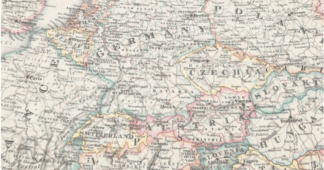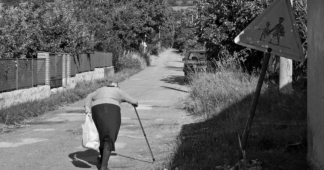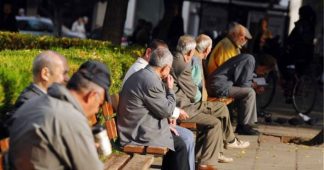The government is trying to entice its people back, not entirely successfully.
By Maxim Edwards
March 21, 2020
Ukraine’s president wanders the deserted streets of the capital, Kyiv, feasting in vacated supermarkets and ringing the bells of Saint Michael’s Monastery, in the forlorn hope of reaching someone left to hear them. Elsewhere, a few souls can still be found: A pro-Russian fighter stalks empty buildings in the country’s east; a supermodel wins contest after contest in which she is the only competitor; an itinerant oligarch hammers signs into the ground to “claim” abandoned territory.
The scenes are fictitious—the first from a 2017 episode of a comedy series starring the man who is now Ukraine’s actual president; the others from a 2018 mockumentary—yet they testify to a growing unease in the country over its declining population. This worry pervades much of Ukraine’s immediate region: In a United Nations study, the top 10 countries ranked by their projected population decline over the next 30 years are all in post-socialist Eastern Europe, an area characterized by low birth rates, small numbers of immigrants, and large numbers of departing citizens.
Ukraine nevertheless stands apart. It is still a nation at war, yet in a survey last year, 55 percent of residents named mass emigration as the greatest threat to their country—the UN estimates that Ukraine could lose nearly a fifth of its population by 2050. And whereas politicians in Eastern Europe typically invoke demographic decline as a justification for conservative policies such as restricting abortion rights and providing financial bonuses for large families, Ukrainian President Volodymyr Zelensky has vowed to reverse brain drain by improving his country’s economy and rule of law. In December, he announced a program to draw young Ukrainians back from abroad with promises of preferential loans to start their own businesses upon their return.
Ukraine’s experience also spotlights the fact that, try as they might, governments can do little to arrest emigration and depopulation, whether through populist right-wing programs to incentivize having babies or via financial handouts for returning émigrés. And while many Western countries, including the United States, have focused on the supposed perils or promise of greater immigration, others, such as Ukraine, illustrate the significant cost of a falling population, from the shallow labor force to the nearly abandoned towns that dot the landscape.
Chernihiv offers an example. A picturesque city once surrounded by farmland and dozens of villages, it has suffered hugely from emigration. Kyiv lies just 90 miles away, close enough to draw young people seeking higher wages (many of whom go on to leave the country entirely), and the local agricultural sector has consolidated into larger holdings that depend less on manual labor thanks to greater scale and technological advances. These trends have been ongoing for decades, but their consequences are becoming clearer. According to Zhanna Deriy, a demographics professor at Chernihiv National University of Technology, some 29 villages in the Chernihiv region have been struck from administrative lists—their populations died out or left, so, in effect, these places no longer exist. “We’re losing our youth,” she told me. “That’s the reality here.”
Why young Ukrainians leave places like this is no mystery. The country is Europe’s second-poorest, beset by corruption and low living standards, and it shares a border with the European Union. Furthermore, a war with Russia-backed separatists still wages in the east, and has displaced 2 million people, many internally. (Ukraine’s depopulation problem is also tied to high mortality rates: According to Ella Libanova, the director of the Ptoukha Institute for Demography and Social Studies at the National Academy of Sciences, 30 percent of 20-year-old Ukrainian men won’t make it to their 60th birthday, thanks in large part to alcohol abuse and road accidents.)
So Ukraine’s limited ability to stem emigration is not entirely an issue of political will. Rather, it is a consequence of the country’s place in the global economy: as a reservoir of migrant labor. In 2018, the most recent year for which data is available, the majority of first-time EU residence permits were given to Ukrainians, the lion’s share of whom moved to neighboring Poland. Remittances from overseas made up more than 11 percent of Ukraine’s GDP. That Ukrainians are heading to Poland and elsewhere in Central Europe also highlights the absurdity of these countries’ negative rhetoric toward prospective immigrants: “One of the paradoxes of [Central European] anti-migrant rhetoric toward the south … is that it’s only possible because those countries have benefited heavily from migration from the east,” Alexander Clarkson, a European-studies lecturer at King’s College London, told me.
Another part of the problem for Kyiv is that it has antiquated and unreliable statistics, making it harder to formulate policies to address the significant outbound flow of citizens. Ukraine’s population stands at a little more than 48 million—or at least it did in 2001, when the most recent census was taken. An array of political crises, conflicts, and more urgent issues have meant that, time and again, successive Ukrainian governments have kicked the can down the road when talk has turned to carrying out a full count of the number of people in the country. (This is by no means unusual: A census can be hugely political, and governments are not always keen to learn about changing population figures, or the shifting balance among different groups.) As a result, few Ukrainians believe the official tally. Libanova, for example, reckons that the total is as low as 35 million (the World Bank estimates the number to be 44.6 million, while the European Commission puts it at 42.2 million). Zelensky campaigned on a pledge to finally conduct the census, which will happen this year.
The political resonance of this emigration is significant. Less sympathetic observers, such as pro-Kremlin media outlets, portray Ukrainian émigrés as voting with their feet, casting a damning verdict on the country’s Western-facing future. Zelensky himself faces pressure over the issue: In a candid interview in August, Ihor Kolomoisky, a Ukrainian oligarch widely suspected of being behind Zelensky’s candidacy, described reducing mass emigration from Ukraine as the president’s “key performance indicator.” If Zelensky failed, the tycoon predicted, he’d be out.
To be sure, just because Ukrainians have physically left the country doesn’t mean they are disinterested in its future. Along with the remittances they send back home, young Ukrainians remain engaged with politics there, Viktor Kotigorenko, the head of Kyiv’s Kuras Institute for Political and Ethno-National Studies, told me. Libanova avoids the term depopulation crisis, which in her view confounds attempts to discuss the problem rationally and implicitly cedes ground to extreme and unproven solutions. And, she argues, there is something democratic in Ukrainians being able to leave at all, to build a life outside the country. “For all of humanity’s history, people have wanted to live longer, and to choose where they can live,” she told me. “For some of us, both those things have happened. That’s evolution.”
Still, however things evolve, Ukraine isn’t fully in control of whether its people will stay (or return). “Even 10 years from now, the quality of life in Ukraine will differ significantly from Poland,” Libanova said. “By all indications, Poland is an economic success, but Poles still travel Europe in search of better jobs. Nothing depends on us.” Clarkson also believes that, if current trends continue, Ukraine is destined to suffer the same fate as the rest of Central Europe: labor shortages at home while locals work abroad. “Give it 20 years, and Ukrainians will be complaining about Afghan migrant workers,” he said.
For now, the reality on the ground in Ukraine is grim enough. In Zelensky’s hometown of Kryvyi Rih, streets are festooned with advertisements promising work in the EU, mostly in Poland, Lithuania, and Romania. “Zelensky is like so many people I know from here,” Ruslan Ibragimov, a local activist, told me. “As soon as they become successful, they leave.”
Not far from the city’s mayoral office, two parents cast in bronze wait anxiously beneath an arch, a statue originally erected in 2013 to promote family values. According to Ibragimov, its accompanying inscription is now seen by some locals in a different light. “Always waiting,” it reads.
Published at www.theatlantic.com
We remind our readers that publication of articles on our site does not mean that we agree with what is written. Our policy is to publish anything which we consider of interest, so as to assist our readers in forming their opinions. Sometimes we even publish articles with which we totally disagree, since we believe it is important for our readers to be informed on as wide a spectrum of views as possible.











